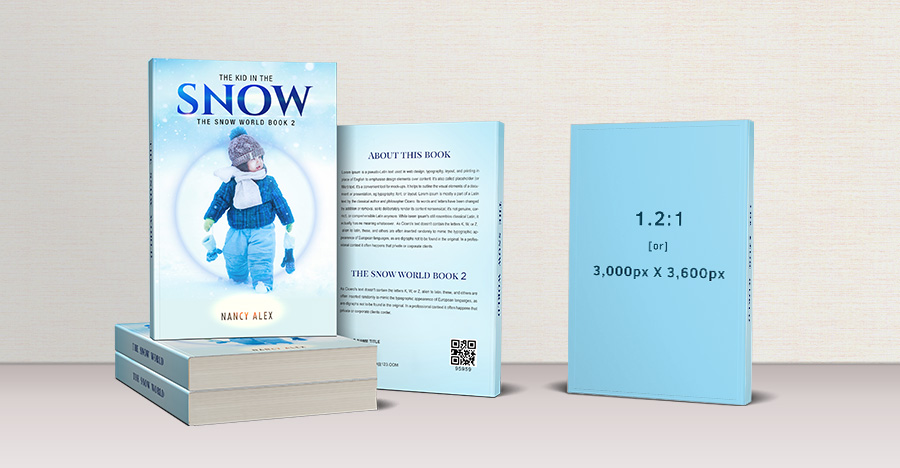In the grand scheme of everything that we talk about regarding the design of book covers, we seldom talk about the dimension of the same. All we talk about is its coloration, how images are used, and even the typography on the cover.
However, what we should also be considering is the dimension of the cover.
In this post, we are going to discuss the standard book cover dimensions for eBooks and print books in pixels and inches.

Dimensions for book cover
Before exploring the process of choosing the dimensions, you must know about the standard book cover dimensions available in the market for different types.
Take a look.
Book cover size in pixels
The standard size for Kindle Direct Publishing (KDP) for eBooks is 2,560 (width) pixels x 1,600 (height) pixels at a 1.6:1 aspect ratio.
For non-fiction and novels, the size is 2,800 (width) pixels x 3,920 (height) pixels if the aspect ratio is 1.4:1, and with the aspect ratio of 1.2:1, the size will be 3,000 (width) pixels x 3,600 (height) pixels.
For audiobooks, the size must be 3,200 (width) pixels x 3,200 (height) pixels at the aspect ratio of 1:1.
We understand that these numbers can become extremely confusing for you. To provide the best experience to the readers, the book cover width should be greater than 2500 pixels. But as we go on explaining more details about the book cover layouts and dimensions, you will be able to understand them better and make complete sense of it.
How to Choose the Size and Shape of the Cover of your eBook
If you consider the most popular eBook readers such as Kindle, iPad, and Nook simple, they all come with an aspect ratio of 1.33:1. Well, what it means is that, when you have a 100 pixels width for the cover, it must have a 133 pixels height.
However, you need to realize that no publisher creates an eBook that fits Kindle perfectly. What happens when an eBook is rendered on various eReaders is that it aligns the book onto the center for the best user experience and render.
Since eBook designs you create are also important from a business point of view, you need to consider how your book will perform in a retail shop rather on eReaders alone.
How does Amazon Kindle work with Book Cover Designs?
It might surprise you to know that Amazon Kindle gets very flexible with the dimension of the book cover a publisher can upload to their site.
However, they have the following things in mind when letting a publisher upload the cover of their eBook.
When it comes to Amazon book cover design in Photoshop the recommended dimension size of your eBook is 1.6:1, which means that for every 1000 pixels of width, the height must be 1600 pixels.
Since the major objective of a cover page is to draw people to it, the cover page must have the best quality. As such, for High-Definition devices, the height should be 2500 pixels at the minimum.
- Ideal dimensions for the book cover in pixels in Kindle is 2600:1600 pixels
Non-Fiction and Novels
If you have noticed, most of the publisher’s display, on the title’s Kindle page, the original dimension of the original cover design. It will mostly have an aspect ratio of 1.5:1.
Though it is a little wider than the recommended size by Amazon, the major advantage of the wider aspect ratio is that the publisher gets more room to incorporate effective designs.
- For the best experience at this aspect ratio, the best dimension is 2500 x 3750 pixels.
Illustrated Books
The books that fall into the category of illustrated such as cookery, art, and photography, most of the time, have a wider area so as to encompass the imageries on the cover. As such, those book covers have an aspect ratio of 1.2:1 or 1.4:1.
The aspects ratios are selected to complement the cover design of the book as the cover is an increasingly important selling point for all of the illustrated books.
Hence, the aspect ratios are established to complement this important aspect.
- 2800 x 3920 pixels is the best dimension to utilize the 1.4:1 ratio
- 3000 x 3600 pixels is the best dimension to utilize the 1.2:1 ratio
Audio Books
Audiobooks have been steadily growing its appeal across the world as it is easier for people to listen to a book rather than reading it.
Like any other type of book, the cover design dimensions are important for an audiobook, too. Providing a throwback to the old times of CDs, the audiobooks have the aspect ratio of 1:1.
Most of the time, what a publisher does after launching the book, is to record the audiobook and publish the same with the same cover. This can make the existing cover look cropped. Hence, if you are planning to do that, we implore you to do not.
You can work with your eBook cover designers to adjust the dimensions of the audiobook to make it better and more alluring to the buyers.
- For the best experience, 3200 x 3200 pixels is the ideal dimension for the aspect ratio of 1:1
As you have understood the dimensions of your eBooks, let us now look at the dimensions of printed books.

How to Choose the Ideal Dimension for Your Printed Books
Most of the time, a publisher wants to create printed books along with the e-versions of the same. In such a case, the trim of your books will decide the success of the book. While you are thinking about the size of the trim, you need to keep two important things in your mind; a) the cost of printing, b) each book category has a standard size measurements. The same goes for paperback book cover dimensions, as well.
After having decided on the trim, you need to understand how it will affect the design and size of the hardcover cover design. There are various PODs (Print-on-demand) that will need their clients to submit the front and back covers as well as the bleed and the spine.
5 w x 8.5 h (in inches) is the standard size for paperbacks
6 w x 9 h (in inches) is a popular trim size.
However, be cautious when choosing of larger sizes, over 6″ w x 9 h ″ or 7″ w x 10 h ″.
You can calculate the width by adding two times the bleed, two times the trim width, and the spine width. The height, on the other hand, can be arrived at by finding the sum of the trim height and two times the bleed.
While this can be a little—okay a lot more—confusing for an average publisher, if you seek the help of a professional cover design company, they will take care of all of it for you. This is the best option as you will need to otherwise have the entire infrastructure, software program, design tools and other paraphernalia with you to get the best cover.
What Are Industry Standards for Book Cover Design?
The standards for ebook cover design are typically determined by a number of factors that are mentioned as follows:
Choosing the Right Book Cover Size
There are certain factors that affect the cover size of a book. Here’s a list of what you need to take into account:
The Resolution You Need to Choose
If you are seeking the help of IngramSpark and Createspace/KDP Print, you are required to have 300 DPI for your cover design to get the best experience.
You need to keep in mind that the CMYK coloration is better than RGB for most cover designs.
